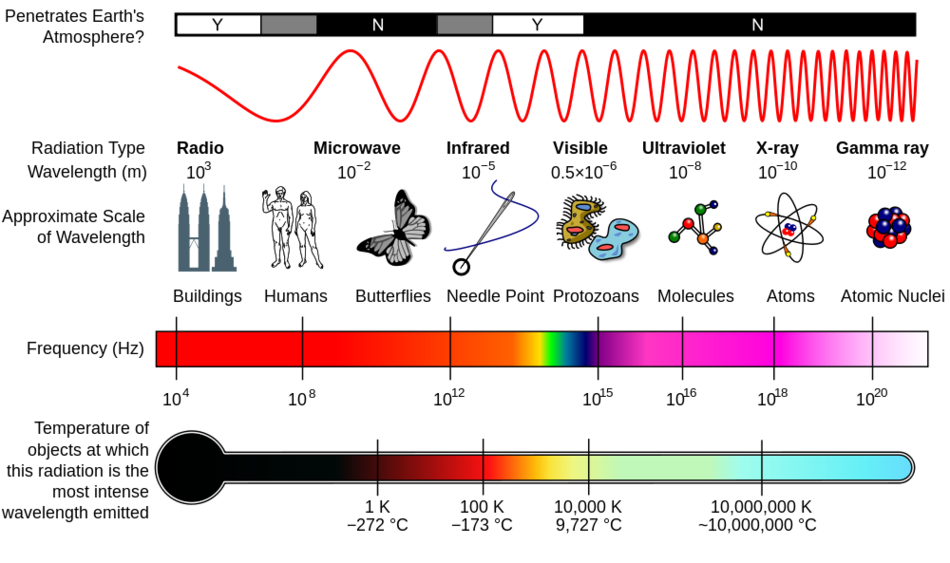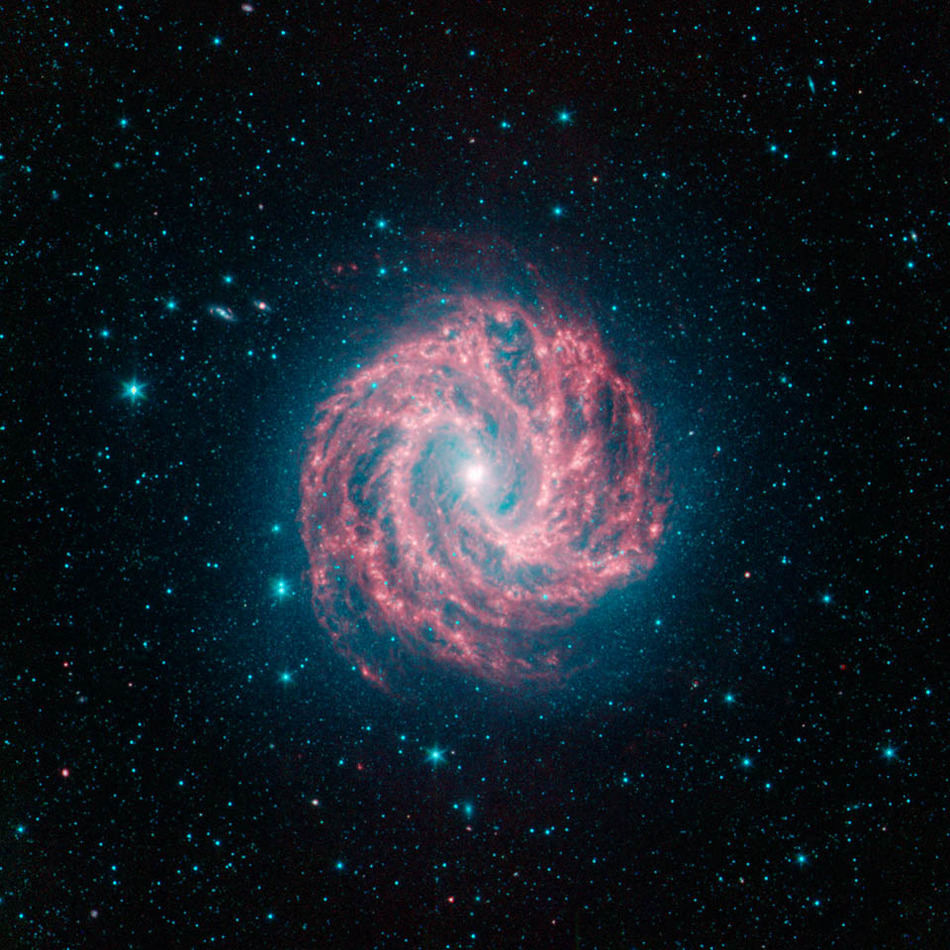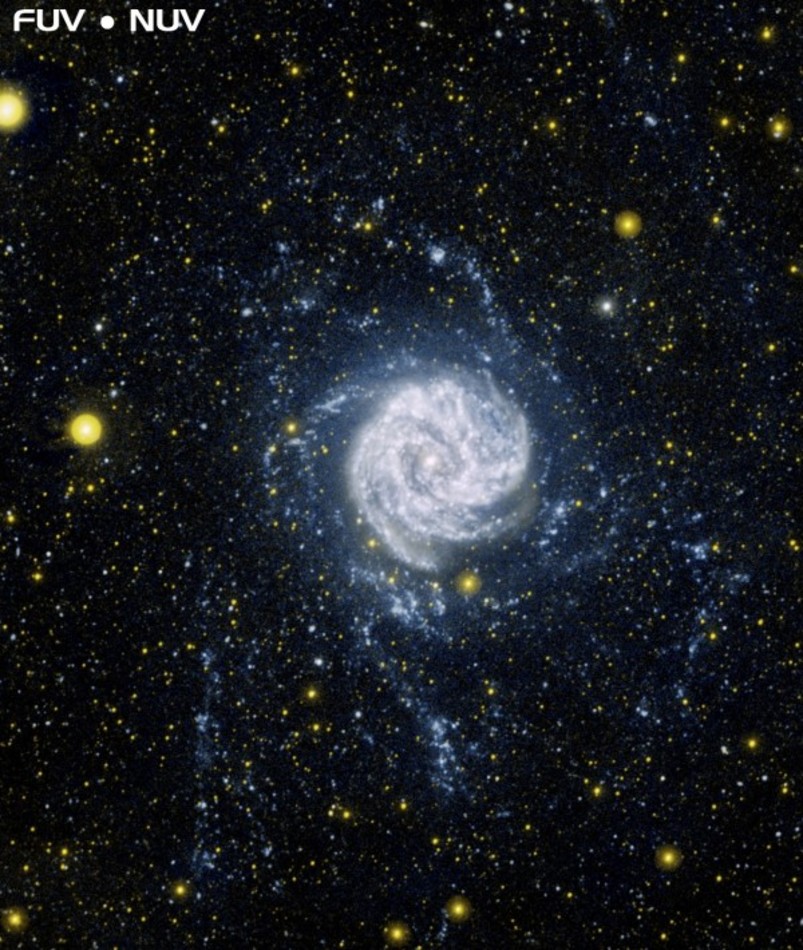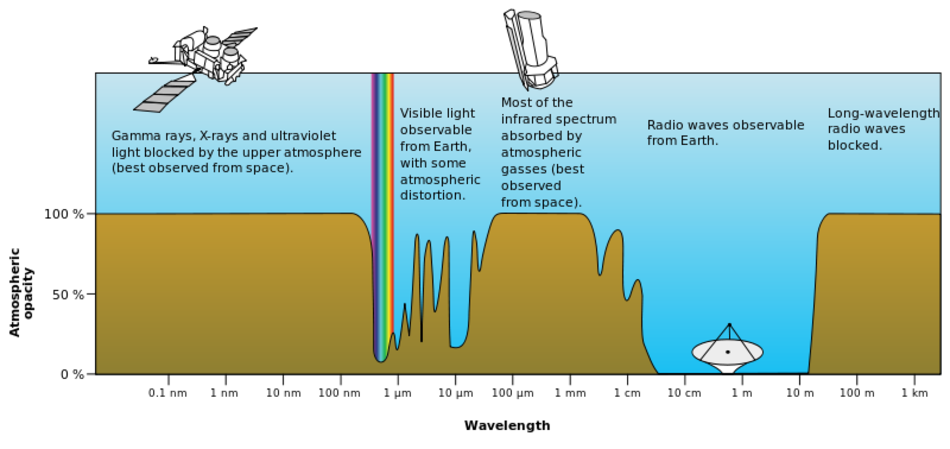
The electromagnetic spectrum is the range of all possible wavelengths of electromagnetic radiation, ranging from high energy gamma rays through visible light and down to low energy radio waves. Various astronomical phenomena can only be observed via specific wavelengths different from visible light. By scanning the sky in the complete spectrum of electromagnetic radiation via optical telescopes, X-ray telescopes, microwave telescopes and radio telescopes, astronomers gather information that wouldn't be accessible if they were just observing via visible light. Visible light is a small fraction of the entire electromagnetic spectrum with wavelengths ranging from 380 nm (nanometres or 10-9 m) to 740 nm. The whole bandwidth of the spectrum is illustrated in the following image.
All the different types of electromagnetic radiation consist of photons of a specific wavelength. All objects that are warmer than their surrounding (that includes all the astronomical objects like stars, nebulae, planets, etc.) emit photons within a certain range of different wavelengths. This range almost exclusively depends on the surface temperature of the object that is emitting the electromagnetic radiation; it's not a characteristic of the matter of the object itself. Very hot objects of a million K or more emit their radiation mainly in gamma and X-rays while cooler objects emit photons with longer wavelengths, such as infrared or radio waves. Further information can be found in our article about black body radiation.
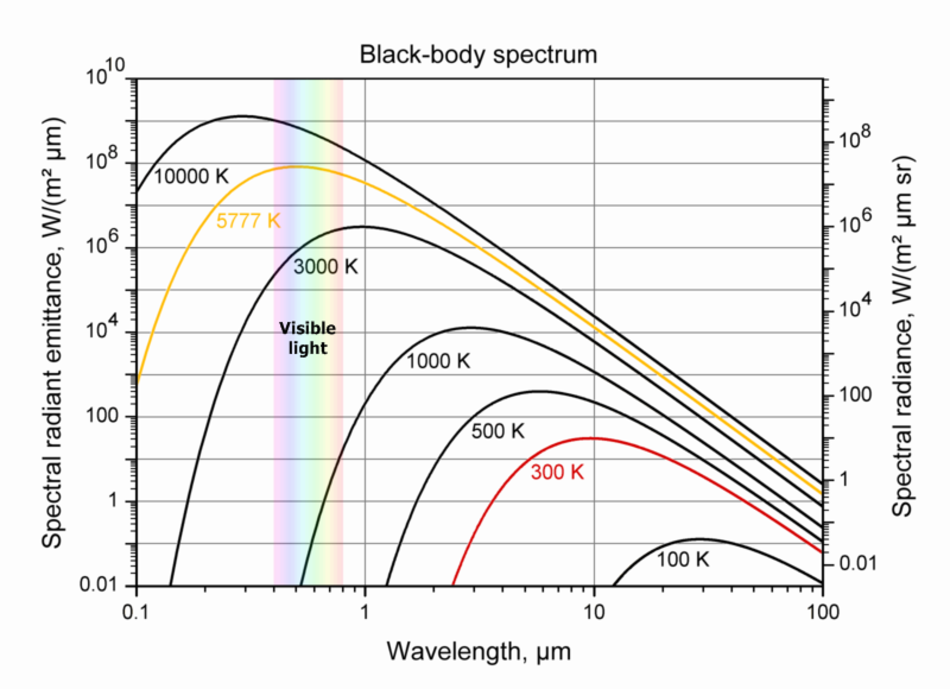 Wien's displacement law showing the relationship between emitted radiation and the temperature of a black body, Source: Wikimedia Commons user Sch, adapted by Sun.org
Wien's displacement law showing the relationship between emitted radiation and the temperature of a black body, Source: Wikimedia Commons user Sch, adapted by Sun.orgIn the above image you can see at which wavelength (or colour) bodies of a certain temperature emit their maximum intensity. A star with a surface temperature of, for example, 10000 K emits the majority of its radiation in the ultraviolet range and still a significant amount in the blue range of visible light. A star with a surface temperature of 4000 K has its peak emission in red. That's why hotter stars appear bluer and cooler stars redder. If we want to observe all the objects in the universe that emit radiation we cannot just observe the visible light, we also need to look at all the other wavelengths. Only with help of infrared and radio telescopes will we be able to detect cooler objects, such as brown dwarfs, dust or molecular hydrogen. With X-ray telescopes we can much better distinguish the sources of high energy radiation, such as black holes and neutron stars.
The intensity maximum of the Sun, which has a surface temperature of about 5800 K, is within the wavelength of visible light (it's about 500 nm). So, it's no coincidence that our eyes are very good at detecting visible light but they do a lousy job at detecting, for example, infrared light. We are only able to see radiation in the narrow bandwidth of visible light which is emitted by bodies with a temperature of more than a few hundred °C, such as our Sun or hot iron that starts glowing at temperatures above 400°C (750 °F). If our Sun was a red dwarf with a surface temperature of just 3000 K or lower your eyes would be perfectly adapted to see infrared light. Remember that we are just talking about bodies that emit light. We can see the moon even though the moon is nowhere near hot enough to emit visible light; we just see the sunlight that is reflected from the surface of the moon.
As we said, we need more than just telescopes that observe visible light to be able to detect the whole bandwidth of electromagnetic radiation in the sky. But what exactly can we additionally "see" using all wavelengths of electromagnetic radiation? Let's have a look at images of the Southern Pinwheel Galaxy (M83) as we observe it via different wavelengths and see what kind of information is revealed with each wavelength. M83 is a 15 million light years’ distant spiral galaxy in the constellation of Hydra with more or less half the diameter of our Milky Way. This is how it looks in visible light:
 Southern Pinwheel Galaxy M83 in visible light. Image credit: European Southern Observatory (ESO) / Lars Christiansen.
Southern Pinwheel Galaxy M83 in visible light. Image credit: European Southern Observatory (ESO) / Lars Christiansen.You can see the roughly spherical core of the galaxy - also called the bulge - in the centre of the image. The spiral structure of M83 is clearly visible. Spirals are regions with more than the average number of newly-formed and bright stars which shine intensely in white and blue. The spirals also contain a larger number of star-forming regions (red emission nebula). There are as many stars in the less bright regions between the spirals, but these stars are older and thus their luminosity is much lower, so these regions shine with much less intensity than the spirals. You can read our article about stars to understand the correlation between the mass, luminosity and lifespan of stars. Furthermore, you can see dust lanes (the dark areas) that will become new stars and planets in the next billions of years. We see the galaxy disk almost face-on with a very small inclination.
Let's switch to another wavelength, the near infrared. Radiation of this wavelength can penetrate the obscuring dust, so we are able to see many more stars that were not visible in the above visible light image.
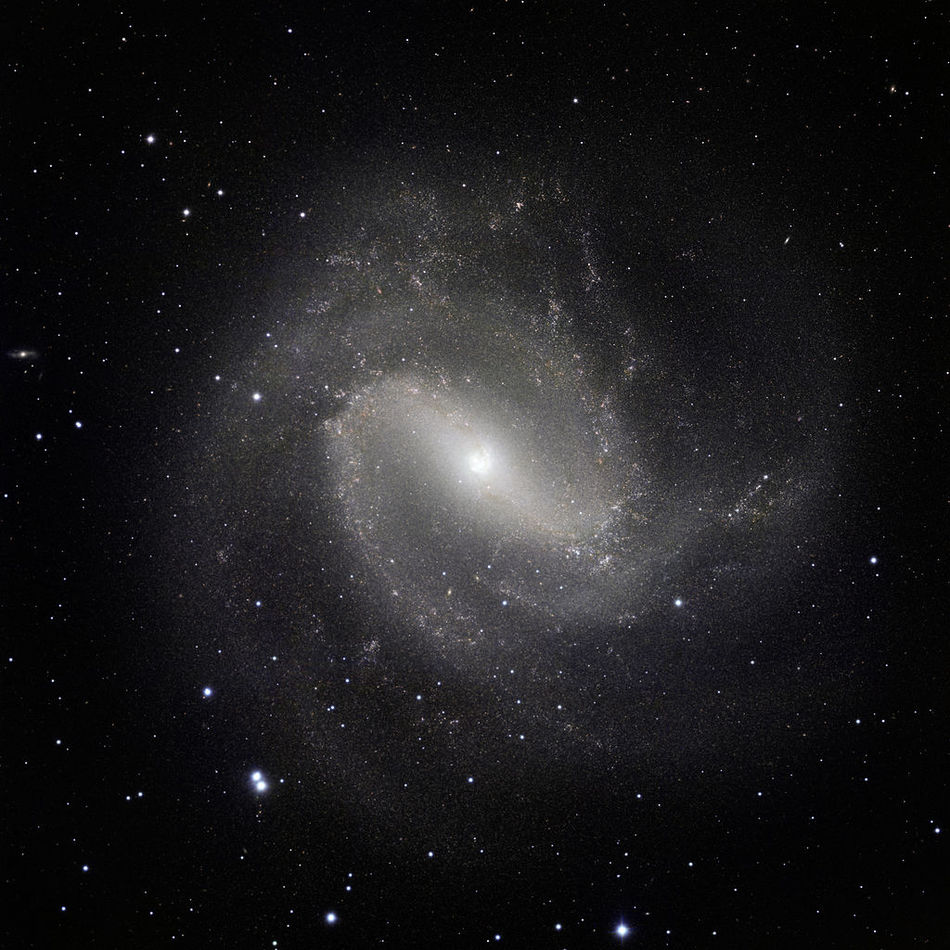 Southern Pinwheel Galaxy M83 in near infrared. Image credit: ESO / M. Gieles. Acknowledgement: Mischa Schirmer.
Southern Pinwheel Galaxy M83 in near infrared. Image credit: ESO / M. Gieles. Acknowledgement: Mischa Schirmer.Again you see the youngest and brightest stars in the spirals, but you better understand that the regions between the spirals are populated too. If we observe M83 in still further infrared we are able to see the distribution of dust in the galaxy, red in the following image.
In general, cooler objects of a few hundred to a few thousand degrees Kelvin emit most of their energy in infrared wavelengths (see our article about black body radiation. Now let's have a look what radio emissions (even longer wavelength) and the more energetic ultraviolet emissions (shorter wavelength than visible light) can reveal. The following image is a composite image of these two wavelengths.
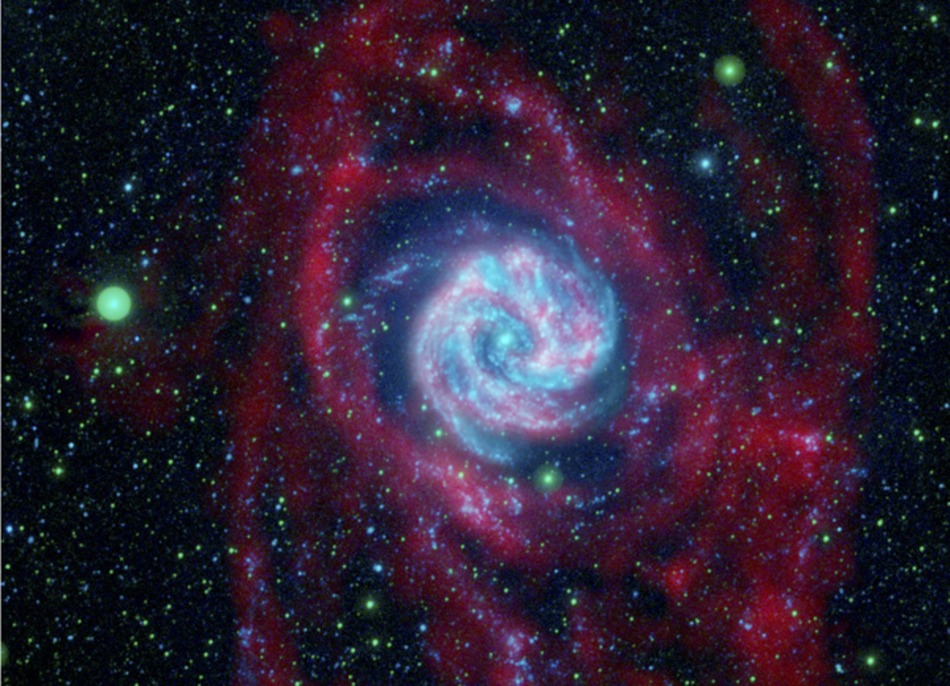 Southern Pinwheel Galaxy M83 in radio light (red) and ultraviolet light (blue). Image credit: Courtesy NASA / JPL-Caltech / VLA / MPIA.
Southern Pinwheel Galaxy M83 in radio light (red) and ultraviolet light (blue). Image credit: Courtesy NASA / JPL-Caltech / VLA / MPIA.The radio waves in red show us where cool and neutral hydrogen atoms reside. These hydrogen-rich arms reach far outside the visible part of the galaxy. The ultraviolet light in blue reveals the youngest and hottest stars that formed about 1 million years ago. If you observe a pure ultraviolet image of M83 you can better see that star formation extends well beyond the visible part of the galaxy too.
Finally, we can use X-ray images to uncover the areas with the hottest temperatures.
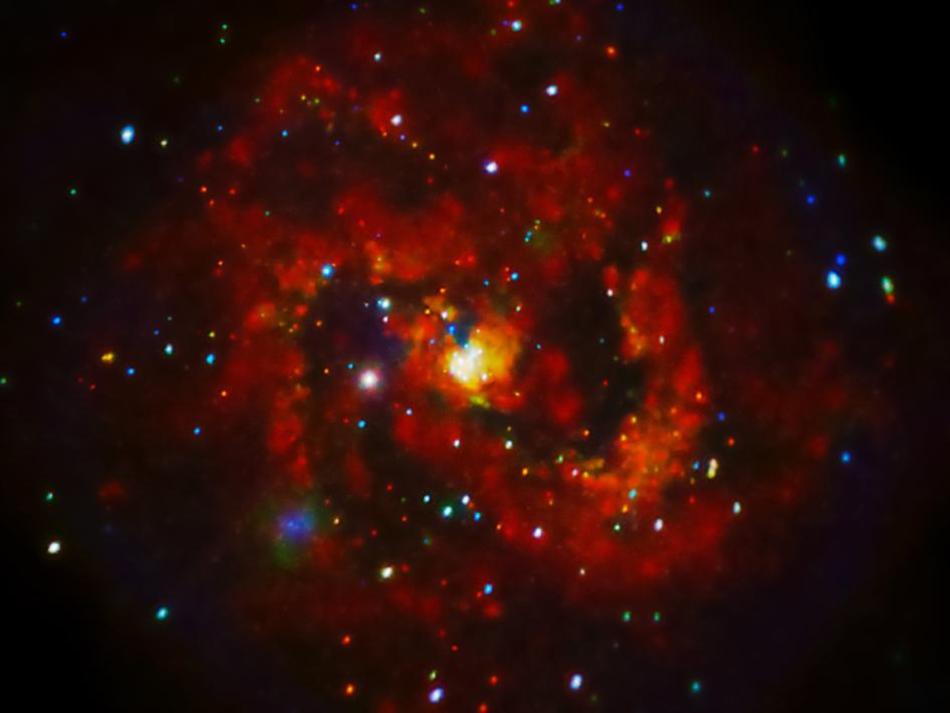 Central part of the Southern Pinwheel Galaxy M83 in X-rays. Image Credit: NASA/CXC/Curtin University/R.Soria et al.
Central part of the Southern Pinwheel Galaxy M83 in X-rays. Image Credit: NASA/CXC/Curtin University/R.Soria et al.Gamma rays and X-rays are the radiations with the highest energy. Only objects of temperatures from a million to hundreds of millions degrees Kelvin (K) emit this kind of radiation. Matter falling into a black hole or a neutron star is accelerated and heated up to millions of degrees. So gamma rays and X-rays tell us where these objects are located. The bright red spot to the left side of the galaxy's centre is a so-called ultraluminous X-ray source; a black hole or neutron star that accretes matter from an accompanying star. In this image of the galaxy's centre you can also observe a lot of hot gas with temperatures of many millions of degrees K.
The problem with some wavelengths like gamma rays, X-rays and parts of infrared light is that they are absorbed by the Earth's atmosphere. Well, in reality it's not a problem but a good thing since you would not like to be X-rayed from space all the time you walk around under a clear sky. But in order to observe these wavelengths we have to send telescopes into Earth orbit or to high altitudes either by launching satellite telescopes or with help of balloons or planes. The Boeing 747 SOFIA (Stratospheric Observatory for Infrared Astronomy), decommissioned in September 2022, is an example of such an airplane-based telescope for infrared observations. It was a collaborative project between NASA and the German Aerospace Center (DLR).
 NASA's SOFIA (Stratospheric Observatory for Infrared Astronomy). Image Credit: NASA photo / Jim Ross.
NASA's SOFIA (Stratospheric Observatory for Infrared Astronomy). Image Credit: NASA photo / Jim Ross.So to sum up, we use:
- radio waves to detect, for example, interstellar gas and dust
- infrared mainly to see all objects with lower temperatures of a few hundred to a few thousand degrees Kelvin, such as cooler stars, dust or brown dwarfs. Infrared is also very important for detecting the most distant galaxies. Their light was emitted billions of years ago as visible light but was redshifted on its journey from visible wavelengths to infrared due to the expansion of the universe.
- ultraviolet light to see the youngest stars - or in other words the regions of star formation
- gamma rays and X-rays to identify matter falling towards black holes and neutron stars
Finally, you can better understand the problem of ground-based observations by realising that only the visible light, some narrow windows in the infrared and parts of radio waves are observable from the surface of the Earth.
